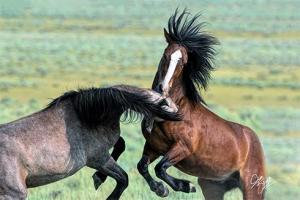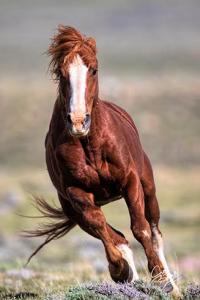The Preventable Travesty Of North Lander
With the many reports about the recent torture and death of a wolf pup legally rundown by snowmobile on February 29th near Daniel, people around the world have focused on the state of Wyoming. Particularly looking at the way wildlife is treated. Wild horses are a significant presence on Wyoming public land, decorating landscape, improving ecosystems, happily cohabitating with other wildlife species and drawing horse seeking people who improve the local economy.
The Wyoming North Lander Complex is not the best known of the areas in the American west that are home to wild horses. These horses don’t make the news and they do not become desensitized to humans because of excess exposure. It is a remote and rugged area, not easy to access but home to some of America’s last truly wild horses. Wild because they have not been genetically manipulated and culled in recent years as wild herds in other areas have been. Wild horses roaming the isolated, difficult terrain in the eastern part of the Red Desert foot-hills of the Wind River Mountains were granted protection in 1971 with the signing of the Wild Free Roaming Horse and Burro Act. Quoting Barbara Moore, wild horse advocate, “They now face extinction due to a plan designed and carried out by the very organization that is charged with their care, The Bureau of Land Management (BLM).”
These statistics can be found on the BLM’s website. The North Lander Complex (NLC) roundup is scheduled to begin on July 1, 2024. 2,806 horses will be gathered, 2,766 permanently removed, 40 returned to the range after treatment with immunosuppressant birth control or permanently sterilized by means of surgery or use of intrauterine devices (IUD). This will leave just 320 horses relatively undisturbed.
The 4 herd management areas (HMA) comprise the NLC , Conant Creek, Muskrat Basin, Dishpan Butte and Rock Creek Mountain have a total area of 370,330 acres. That translates to 1,157 acres per horse for the remaining 320, far exceeding the amount necessary sustain a horse.
Wyoming native, wildlife photographer, Jim Brown has lived his entire life in close proximity to the NLC. His comment when asked about the impending roundup, “These Wild horses will be taken from their home in the High Plains of Wyoming, go to short-term BLM holding corrals, knee-deep in manure, mud and disease that kills large numbers as the last couple years have shown.” Brown is referencing 145 horses reported by the BLM as having died in 2022 at the Canon City holding in Colorado while Wheatland holding in Wyoming was experiencing losses from the same condition, Streptococcus equi infection, commonly known as strangles. By the BLM’s own admission, the disease outbreak and deaths were caused by lack of vaccinations, required in their own policy, which they failed to administer.
Examining the cost factors of Roundup and incarceration requires checking the BLM website and multiplying horse numbers by costs posted to get daily and yearly totals. The roundup contractor is paid about $800 per horse so the bill for NLC will be approximately $2,244,800. Horses in short-term holding cost the American taxpayer $5.50 per day. The adoption rate from holding is no more than 20%. Horses that are not returned to the range move into long-term holding at $3.53 a day. There are 60,000 horses and burros currently in holding and 10,000 on the schedule for roundup in 2024. The bottom line on that bill is $247,100 per day or $90,191,500 per year.
“Yes, you can go on the BLM expense reporting and see the actual number.” Jim Brown explained, “Now you can see why every mega livestock company is getting in the business of housing wild horses and WHY they are screaming for round-ups.”
If the horses are left on the range free to live and die by natural selection they cost $000. That is correct- Zero dollars billed to the American taxpayer.
Every American has birthright ownership of America’s wild horse and the public land on which they thrive. The land is being taken from the horses to provide great benefit to very few people. Remove horses to make room for $1.35 per month grazing leases paid in versus $3.53 per day paid out and the American taxpayer is the loser.
Willamette University Professor of Animal Law, equine advocate, Scott Beckstead contributed, “The BLM has created self-sustaining wild horse roundup industry which enriches few and allows them to ignore the millions of American taxpayers who pay the price. JR Simplot Company is just one example. The livestock company benefits from the reduced rate grazing leases that the BLM sells, they also make millions of dollars as a long term private holding facility for the horses that the BLM rounds up. Private facilities hold horses with no public visitation so the conditions are not monitored and regulated.”
Genetic viability issues are next in line after financials but there is a tie in. The BLM requested an independent study and recommendation by Dr. Gus Cothran and his team of genetic specialists at Texas A&M. When asked about the results of the study indicating that the herd numbers should not be reduced below the level indicated in the report, Clay Stott, Wyoming Office BLM Wild Horse Specialist said, “the question is based on the idea that Doctor Cothran has a say in the management of Dishpan Butte HMA. This is not the case.”
This begs the question…Why pay for a study and not ignore it?
Please follow as we continue with an examination of the herd divisions on the 4 HMAs, genetic viability, discussion of range conditions, disregard for government policy and a deeper dive into misappropriation of taxpayer dollars concerning the iconic wild horses of Wyoming.
Barbara C. Moore
Equine Collaborative International
+1 716-912-2100
411eci@gmail.com






